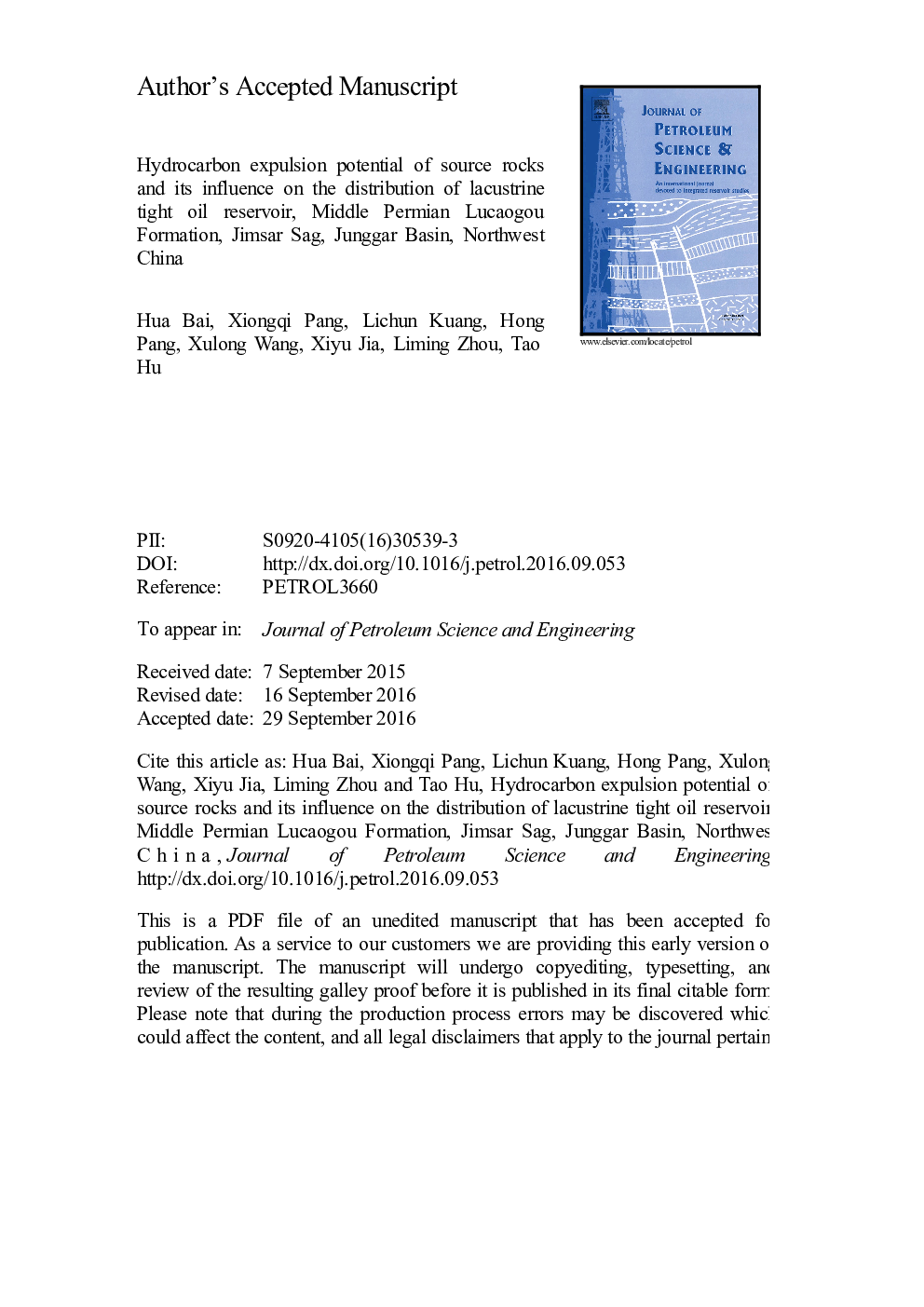| کد مقاله | کد نشریه | سال انتشار | مقاله انگلیسی | نسخه تمام متن |
|---|---|---|---|---|
| 5484510 | 1522792 | 2017 | 39 صفحه PDF | دانلود رایگان |
عنوان انگلیسی مقاله ISI
Hydrocarbon expulsion potential of source rocks and its influence on the distribution of lacustrine tight oil reservoir, Middle Permian Lucaogou Formation, Jimsar Sag, Junggar Basin, Northwest China
دانلود مقاله + سفارش ترجمه
دانلود مقاله ISI انگلیسی
رایگان برای ایرانیان
کلمات کلیدی
موضوعات مرتبط
مهندسی و علوم پایه
علوم زمین و سیارات
زمین شناسی اقتصادی
پیش نمایش صفحه اول مقاله

چکیده انگلیسی
The petroliferous Permian system of the Junggar Basin in northwest China is predominantly a conventional oil exploration region. To assist in the unconventional tight oil reservoir exploration, the hydrocarbon expulsion potential of source rocks and its influence on the tight oil distribution of the Middle Permian Lucaogou Formation (P2l) in the Jimsar Sag are discussed. The researches are based on geological and geochemical characteristics such as the distribution, abundance, type, thermal maturity of source rocks, and “sweet spots”. Meanwhile, hydrocarbon expulsion intensity and quantity were evaluated with hydrocarbon generation potential method. The Middle Permian Lucaogou source rocks have wide distribution and high thickness (mostly thicker than 100Â m). The source rocks exhibit low to high TOC (mainly ranges from 1.0Â wt% to 5.0Â wt%) and primarily contain type-II kerogen, resulting in significant hydrocarbon expulsion potential under moderate mature thermal evolution (Ro mainly ranges from 0.55% to 1.05%). According to the hydrocarbon expulsion modelling, the source rocks reached the hydrocarbon expulsion threshold at 0.73% Ro and the hydrocarbon expulsion rate became greatest at 0.9% Ro. The comprehensive hydrocarbon expulsion efficiency was approximately 48%. About 18.7Ã108Â t of hydrocarbons were expulsed from the Lucaogou source rocks in the Jimsar Sag. The hydrocarbon expulsion intensities are relatively large and rang from 150Ã104Â t/km2 to 400Ã104Â t/km2 in the center and west area of the Sag, where is the superimposed area of source rock thicker than 200Â m, TOC greater than 3.5% and Ro higher than 0.85% in the sag. There are 17 exploratory wells obtaining commercial oil flow in the Sag. 16 of the 17 exploratory wells are located in the area with hydrocarbon expulsion intensity greater than 50Ã104Â t/km2. By contrast, other exploratory wells outside the hydrocarbon expulsion coverage area have slight show of oil, even dry. In addition, there is positive correlation between the hydrocarbon expulsion intensity and the daily output of well testing. It is concluded that the tight oil exploration should focus on the area with hydrocarbon expulsion intensity greater than 100Ã104 t/km2, which is a favorable area for commercial hydrocarbon accumulation and exploration.
ناشر
Database: Elsevier - ScienceDirect (ساینس دایرکت)
Journal: Journal of Petroleum Science and Engineering - Volume 149, 20 January 2017, Pages 740-755
Journal: Journal of Petroleum Science and Engineering - Volume 149, 20 January 2017, Pages 740-755
نویسندگان
Hua Bai, Xiongqi Pang, Lichun Kuang, Hong Pang, Xulong Wang, Xiyu Jia, Liming Zhou, Tao Hu,